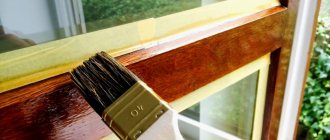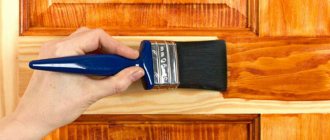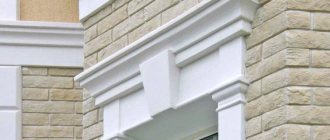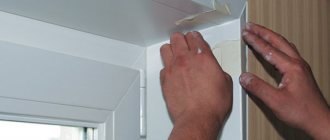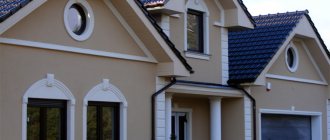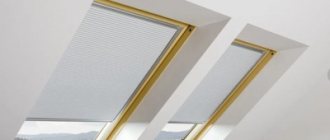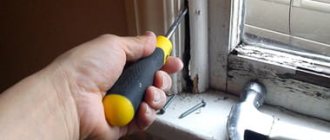Types of paints
Various types of compositions are used to paint window frames. Each of them has its own characteristics that must be taken into account.
Alkyd paints
Universal composition having a pentaphthalic and glypthal base with the addition of a certain amount of natural oils. It takes a little time for the formed coating to dry. Each layer dries in less than a day. It turns out elastic. Withstands significant temperature fluctuations. Retains integrity in frosts down to -50C and in heat up to +60C.
If the application technology is followed, it is possible to form a smooth coating with good water-repellent properties. Manufacturers offer paint in various colors, which allows you to choose the composition of a suitable shade. White spirit and solvent are used as solvents. The average consumption varies in the range of 100 – 180 g/m2.
The introduction of oils and resins into the paint prevents temperature fluctuations in wood, its swelling and burning. A high level of biological protection prevents damage to wood by insect pests, which significantly extends the service life of the window unit. A properly formed protective coating can last at least 5 years. The disadvantages of alkyd paint include its toxicity and flammability.
Acrylic paints
This category includes water-soluble brands with polymers. They do not contain harmful fragrances. This prevents the appearance of a characteristic pungent odor. The introduction of a certain amount of polymers ensures resistance to precipitation and sunlight.
Acrylic paint:
- Withstands repeated freezing;
- Allows wet cleaning;
- Allows you to form a coating that can last at least 7 years;
- Easy to apply to form an even layer;
- Dries quickly.
Average consumption depends on the brand. It is in the range of 120 – 150 g/m2.
Oil paints
The base is drying oil, to which a certain amount of coloring pigments is added. Allows you to form a fairly strong waterproof film on the surface of the frame that maintains its integrity under the influence of precipitation, frost, and aggressive chemicals. It does not fade in the sun for a long time, has sufficient abrasion resistance and high coverage. Oil paint is available in a wide range of colors.
The average consumption depends on the type of base. For porous ones it is at the level of 200 g/m2, for denser ones it is 100 - 150 g/cm2. Drying oil, white spirit, turpentine are added as a solvent, but not more than 5% of the total volume of oil paint. The popularity of the composition is constantly decreasing. This is due to:
- limited service life of the formed coating, amounting to only 1 - 3 years;
- long drying period of 1 – 2 days;
- introducing a certain amount of flammable substances;
- presence of a pungent odor.
Determining the degree of window destruction
Open the window and inspect the wood where the paint has peeled off. If its density already resembles foam plastic or is even softer, it’s not worth the candle, and it’s better to replace the window. If there are cracks or fungus, but the frame is quite solid , then after restoration the wooden window will last for a long time. Check the geometry of the window and sashes. Aren't they squinting too much?
If the shutters are skewed and when opening they touch the window sill , you will need wooden wedges and steel corners for repairs. Close the window sash tightly. Adjust its position with wedges. Install metal corners in the loose corners of the frame. Secure them with screws. The sashes should now sit firmly in the frame.
The site has material about decorating windows for the New Year holidays. The result will be so beautiful that your windows will become like new!
Perhaps a healthier solution is to replace your old wooden windows with new ones. Read about wooden glazing of balconies in this material.
The glass itself also requires careful inspection. Old and cracked out! Prepare money for something new. We clean and lubricate the fittings, and replace any rusty ones.
Tips for choosing
The compositions offered by manufacturers are divided into several categories. There is paint that is only suitable for work inside the building. Others can be used to paint windows inside and out. When choosing paint, you should give preference to the second option. With its help you can paint the frame on both sides.
The paint, which can be used inside and outside the building, has all the necessary functional properties. Allows you to form an elastic coating with good moisture-resistant properties, which:
- Not afraid of exposure to ultraviolet radiation;
- Maintains integrity under the influence of precipitation;
- Provides a sufficient level of biological protection;
- Safe for people;
- Does not have a pungent odor;
- Durable.
What tools do you need to prepare before work?
Before starting work, you need to prepare your tools. There is no need to save on purchasing consumables. For example, cheap brushes may shed and leave lint on the surface that you will have to clean up. Poor quality rollers can streak and pick up paint poorly. That is why it is best to shop in a professional store.
So, you will need the following tools:
Sandpaper, spatula. Necessary for removing dirt and old coating. It is best to buy sandpaper of different grits.- Pliers and other tools needed to remove old nails, screws, etc.
- Small and large brushes. Small brushes will allow you to paint frames in the most difficult to reach places.
- Roller. It will help you apply the paint as evenly as possible. You can also use rollers in large and small sizes.
- Cans, trays and containers in which the paint will be kept during operation. The most important thing is that the container must match the size of the brush or roller.
- Putty, wood antiseptic, various impregnations, etc. They are applied to already prepared wood to give it additional protective properties. However, many people refuse to use them, making a big mistake.
The duration of the preparatory stage depends on the volume of work and the preliminary condition of the window frames.
Expert opinion
Kukushkin Anatoly Sergeevich
Repair specialist
The frames must be completely dry before painting. Otherwise, after a few months the paint will begin to peel away from the wood and “bubble.”
How and with what to paint?
To get high-quality coverage, you need to choose the right time to complete the work. This will ensure high adhesion of the decorative coating to the base. It is best to choose a warm, cloudy day with minimal humidity to paint windows. It is better to avoid dyeing in sunny weather, as under the influence of ultraviolet radiation some pigments begin to deteriorate. Most manufacturers recommend starting painting if the air temperature is above +5C and the humidity is less than 80%.
Attention! Do not paint a new frame or apply a coating to a wet product. In this case, there is a high probability of bubbles forming inside the coating, due to which it will begin to peel off.
The number of layers applied may vary. If you just need to refresh the window, and the color of the old and new coatings are similar in color, it is enough to apply one layer. If you decide to repaint the frame in a different color, you will need to apply 2–3 layers.
The paint must be applied in a thin layer. When forming a thick coating, there is a risk of drips, sagging and other defects. A thick layer will take longer to dry.
To apply paintwork you can use:
- roller;
- brush;
- spray gun.
When painting frames and bindings, a roller is not always convenient. It is preferable to use a brush or spray gun. Manufacturers indicate the preferred method of application on the packaging. Some brands cannot be applied with a spray gun due to their high viscosity.
When using the spraying method it is possible to:
- reduce the consumption of the coloring composition;
- increase process productivity;
- form a more uniform coating.
When using a spray gun, preliminary preparation of the frame is required. The windows should be completely closed. It is worth protecting the surface that is not subject to painting. After completion of work, the spray gun is thoroughly washed. It must be disassembled into individual elements.
The brush allows you to create a thinner layer. There is no need to completely close the windows. Simply apply masking tape along the contour of the frame. After completing the work, the brush is cleaned of the composition. When using a brush, consumption and time costs increase.
Coating the old layer
If you are thinking about how to paint wooden windows using old paint, then better give up this idea. It is not for nothing that one of the main conditions for proper window painting is the removal of the old coating. If you apply a new layer to an old one that has already cracked from time to time, you risk getting a result that is not at all what you expected. The new paint will begin to bubble on top of the old layer, unevenness and roughness will appear - it will not look aesthetically pleasing and will negate all efforts.
Do you like wooden windows? Read how to choose a good wooden window in our material at the link https://oknanagoda.com/okna/derevo/kak-vybrat-derevyannoe-okno.html. Read our article on the website which wooden double-glazed windows are preferred by Russian buyers.
Do you want beautiful wooden windows? Read our article “Arched wooden windows – beauty, and that’s all!”
TOP 15 best paints
If you can’t find the right composition, we suggest you get acquainted with the TOP 5 paints for painting windows. Compare their advantages and disadvantages to choose the most suitable one.
Alkyd
TIKKURILA EURO PESTO 30
A universal composition designed for indoor work. Forms a semi-matte coating with high dirt and water repellent properties. Allows application using various tools. To form a coating of sufficient thickness, several layers can be applied. Before applying each subsequent one, at least a day must pass. Supplied in 0.9 liter containers.
The average price of one can is about 758 rubles.
pros
- Possibility of frequent washing using detergents;
- Tinting in different colors;
- No pungent odor;
- Using a roller, brush, or spray to form a coating.
Minuses
- Price;
- Indoor use only.
Semi-gloss window paint Tex with plastic effect
Special purpose alkyd enamel, developed specifically for painting window frames and doors. Can be applied to various types of substrates indoors and outdoors. Using paint weighing 1 kg you can paint an average of 7 - 9 squares. Consumption depends on the chosen application method and the procedure for preparing the base.
Can be applied by brush, roller or spray. Sold in cans weighing 1 and 3.7 kg. White spirit can be used as a solvent. A minimum of 16 hours must pass before each subsequent application. The average price of 1 kg of paint is about 380 rubles.
pros
- Semi-gloss white finish;
- Good resistance to precipitation;
- Possibility of washing using chemicals;
- Sufficient wear resistance;
- Possibility of storage at negative temperatures
Minuses
- There is a smell.
Dufa Retail Enamel GLANZ
Alkyd enamel with a characteristic glossy sheen. Suitable for indoor and outdoor use. Can be applied to various types of substrates. White spirit is recommended as a solvent. Average consumption 10 m2/l. For application use a brush and roller. When applied it does not form smudges. Drying the previous layer for 5 – 6 hours at a temperature of +20C. The coating formed according to all the rules does not turn yellow. Supplied in 0.75 and 2.5 liter containers.
The average price of a 0.75 liter container is 330 rubles.
pros
- Resistance to atmospheric precipitation;
- Wear resistance;
- Stable gloss;
- High adhesion to the base;
- Possibility of use when performing work inside and outside the building.
Alpina Fenster and Tur, 0.75 l
Products from a German manufacturer are ideal for wooden bases. Can be applied to solid wood, chipboard, MDF, fiberboard. Allows the use of a roller, brush, spray.
The average cost is 1038 rubles.
pros
- good resistance to precipitation;
- high moisture resistance;
- short drying time;
- resistance to mechanical stress;
- good adhesion to the base;
- preservation of light after a long period of operation;
- the ability to wash the formed coating with household chemicals.
Minuses
- slight odor.
Dufa Seidenmattlack
Semi-matte composition. The manufacturer offers 20 tinting options. Allows you to create an even coating. Contains synthetic resin. Not afraid of exposure to precipitation. Can be applied using a brush or spray gun. Average consumption 10 – 13 m2/l. It smells, but the smell is not strong. It takes about 8 – 12 hours for the layer to dry. Supplied in containers of 0.375; 0.75 and 2.5 l.
The average cost of a 0.75 liter container is 408 rubles.
pros
- Suitable for work inside and outside the building;
- Resistant to ultraviolet radiation;
- Withstands temperature fluctuations;
- Abrasion resistant;
- Seven-year manufacturer's warranty;
- Has good hiding power.
Acrylic
Permacryl Brillant "Trimetal"
Composition based on acrylic resins in a water dispersion. Suitable for interior and exterior work. Available in 1 and 2.5 liter cans. Requires preliminary preparation of the base. Allows application by all available methods at temperatures above +10C. Choice of colors available. Supplied with a hygienic certificate of conformity. Average consumption 12 m2/l.
The average cost of 1 liter is 1636 rubles.
pros
- Good adhesion to the base;
- Minimum drying time;
- Sufficient water resistance;
- Forms a stable gloss;
- Retains the original color for a long time;
Minuses
- high price.
Sadolin Optima 45
Highly specialized water-based composition. Made in Switzerland. Available in 1 and 2.5 liter cans. Requires preliminary preparation of the base. The wood is treated with a wood-protective primer. To form a high-quality coating, two layers are applied. Work is carried out at temperatures from 18 to 30 degrees Celsius. Allows the use of all types of window painting tools. Average consumption 10 m2/l. Drying takes at least 2 hours.
pros
- semi-gloss finish;
- safety of application and operation;
- hypoallergenic;
- the composition is completely ready for use;
- good hiding power;
- formation of a durable protective film;
- convenient packaging;
- no strong odor.
Minuses
- over time the surface turns yellow.
"ŚNIEŻKA SUPERMAL"
A high quality water-soluble product that creates a satin fabric effect on the surface of the base. Suitable for exterior and interior use. Made in Poland. Apply to a clean, dry base in 1 – 2 layers. The interval between layers is 5 hours. Allows the use of brushes, rollers, and all types of sprayers. Average consumption 12 m2/l. Dries in 5 hours.
Supplied in cans of 200, 400, 800 ml. It has an average cost of 134, 232, 360 rubles, respectively.
pros
- resistance to external negative factors;
- environmental friendliness;
- high quality;
- formation of a continuous durable film with protective properties;
- safety;
- hypoallergenic;
- excellent coverage;
- presence of antifungal substances in the composition;
- ease of application;
- Availability of various shades.
Minuses
- slight smell.
Aquest – 18, Master, 1.2 kg
Semi-matte paint developed specifically for wooden windows. Mix thoroughly before application. The amount of solvent introduced cannot exceed 5%. Apply to the previously prepared coating in 1 – 2 layers. Work is carried out at temperatures above +5C. Allows the use of all types of tools when applying to the base. It takes only an hour to dry the layer at a temperature of +20C.
The average price is 280 rubles.
pros
- ease of application;
- quick drying;
- long service life;
- affordable price;
- absence of toxic substances.
Svyatozar – 31, semi-matte white
Domestic products. Packaging in containers of 30–40 liters. The paint is bright white, designed specifically for painting wooden windows. Allows tinting in bright colors and pastel tones. Average consumption when applying two layers of paint is 250 – 300 g/sq.m.
pros
- high quality workmanship;
- long service life;
- resistance to precipitation and moisture;
- biological resistance;
- formation of high-quality coating on any basis.
Minuses
- package volume.
Oily
Oil enamel “ŚNIEŻKA SUPERMAL”
Oil-based composition made from high quality phthalic resin. Forms a high-quality coating with a high level of protection. Made in Poland. Apply 1 – 2 layers to a clean, dry base with an interval of 16 hours. Allows the use of all application techniques. Available in several shades.
Supplied in cans of 200, 400, 800 ml and 2.5, 5 l. It has an average cost of 125, 144, 322, 690, 1746 rubles, respectively.
pros
- high quality;
- resistance to precipitation;
- moisture resistance;
- excellent hiding power;
- convenient packaging;
- presence of antifungal substances in the composition;
- Full compliance with regulatory requirements.
"Gjoco Fashion 80"
High quality paint made in Sweden or Norway. Polyurethane is used as a binder. White glossy enamel. Apply by roller, brush or spray at intervals of 6 hours. Forms a high-quality protective coating on a wooden base. Can be used as an intermediate and finishing layer. The average consumption is 7 – 9 m2/l.
The average cost of a 2.7 liter tin can is 3,240 rubles.
pros
- the composition is immediately ready for use;
- has a density of 1.1-1.2 kg/l;
- low consumption;
- Dries to touch in 1 – 2 hours.
Minuses
- sensitivity to frost, which does not allow it to be used for painting window blocks in cold regions.
Prestige MA – 15, 0.8 kg
Suitable for painting wooden and metal substrates. Retains characteristics when heated to 100C. It takes 12 hours for the formed layer to dry completely. The paint is based on premium-grade vegetable oils, to which a certain amount of fillers, metallized pigments, and additives are added. The composition is completely ready for use, but before application it should be thoroughly mixed. To dilute the thickened solution, you can use white spirit or kerosene. Apply by brush or spray. Stored in a cool place.
The average price is 174 rubles.
pros
- long service life of the formed coating;
- external attractiveness;
- availability.
Minuses
- After painting the windows, the room needs long-term ventilation.
Cossack MA – 15, 1.9 kg
Paint based on high-quality drying oil. Allows application in 1 – 2 layers. Consumption 160 – 200 g/sq.m. Diluted with white spirit or solvent. It takes a day for the applied layer to dry. Can be applied at temperatures from +5C to +35C.
The average cost is 227 rubles.
pros
- resistance to atmospheric precipitation;
- durability
- wear resistance;
- availability.
Minuses
- shelf life 1 year from the date of manufacture;
- sensitivity to high temperatures.
The process itself
Paintwork must be carried out at optimal temperature conditions. The right time to renew the frame coating is spring and summer. The window must be painted at a temperature not lower than +5°C, the permissible air humidity is no more than 80%. It is not recommended to paint a wet surface, as the coating will deform and peel off. It is necessary to provide protection during work and purchase a respirator, goggles and gloves.
Restoring the frame must begin with dismantling the window grilles, fittings, and sashes.
Preparatory work also includes high-quality cleaning of surfaces using coarse sandpaper or a scraper. The remaining elements must be protected with construction tape or paper.
It is recommended to remove the glass from the frame; if this is not possible, protect the glass surfaces with newspapers or masking tape. It is recommended to replace old beads with new ones. The elements are painted separately and then attached to the frame.
To apply paint evenly on an old wooden window, a primer and putty of the surfaces are necessary. Metal elements are also treated to protect against corrosion. Wood must be coated with antiseptic agents to protect against mold and rot. Cracks and irregularities are filled with putty. When processing with stain, it is necessary to choose a monochromatic composition.
The primer forms a transparent protective film on the surface that preserves the natural grain of the wood. The treatment prevents the frame from rotting even when exposed to high humidity. But before laying the soil, it is necessary to degrease the surface with special compounds.
Before applying paint to the surface, the composition must be thoroughly mixed in a container.
For the first layer, the material must be diluted with a solvent until a watery consistency is obtained, with which unevenness and cracks are impregnated. The coating must be dried.
The next layer requires paint of a denser consistency to avoid the formation of smudges. If necessary, a third coating can be applied.
Video:
Selection of colors for the facade
Such a problem is practically not encountered when glazing apartments, but owners of private houses and summer cottages have something to think about. As a rule, one of two options is considered - choosing either a contrasting profile color or one that harmonizes with the facade.
When choosing a harmonizing color, they usually give preference to the same shade as the facade, but darker. For example, if the house is decorated with yellow-sand siding, it is better to choose a brown or dark brown profile for glazing.
Gray walls go well with dark gray frames; metallic options or black painting are possible.
The architectural style of the building is also important. Classic options go best with wood-look windows or plain dark shades.
Modern solutions harmonize better with gray or black frames; metallic is also welcome. The extravagant style is the simplest in terms of choosing the color of the windows - any bright colors will do.
Another guideline is the material of the roof and doors. Chocolate-colored metal tiles will look good with the same window profile.
As for doors, in most situations it is better when they do not differ in tone and texture from windows.
The most difficult thing is when choosing a contrasting window design. It is necessary that the glazing stands out against the general background and at the same time remains part of the facade, without causing a feeling of rejection. One option is to use a brighter shade than the walls. For example, against the background of red brick trim, the rich yellow color of the frames looks good.
